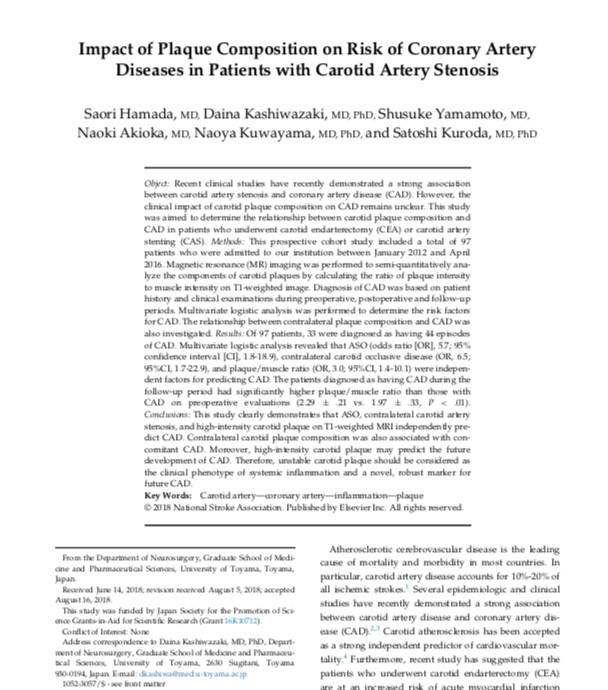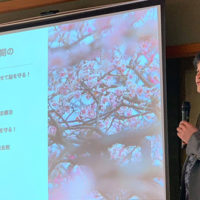
当科の研修医・浜田さおり先生の論文「頚動脈プラーク成分は冠動脈疾患のリスクを予測する」がJournal of Stroke and Cerebrovascular Diseases誌に掲載されました。
MRIのスピンエコーT1強調画像にて高信号を呈する不安定プラークを有する頚動脈狭窄症の患者さんでは、冠動脈疾患の既往、血行再建術(CEA/CAS)の術前検査で冠動脈疾患が発見されるリスク、血行再建術後の経過観察中に冠動脈疾患が発生するリスクが高いことを報告させていただきました。閉塞性動脈硬化症(ASO)、反対側の頚動脈狭窄症も危険因子であり、全身の慢性炎症が深く関与していることを示唆する結果でした。
https://www.ncbi.nlm.nih.gov/pubmed/30219630
A Voyage to Depth of Neuroscience Vol. 52
Our resident, Dr. Saori Hamada published a paper on carotid artery stenosis and coronary artery diseases.
Hamada S, Kashiwazaki D, Yamamoto S, Akioka N, Kuwayama N, Kuroda S.
Impact of Plaque Composition on Risk of Coronary Artery Diseases in Patients with Carotid Artery Stenosis.
J Stroke Cerebrovasc Dis. 2018 Sep 12. [Epub ahead of print]
Abstract
OBJECT:
Recent clinical studies have recently demonstrated a strong association between carotid artery stenosis and coronary artery disease (CAD). However, the clinical impact of carotid plaque composition on CAD remains unclear. This study was aimed to determine the relationship between carotid plaque composition and CAD in patients who underwent carotid endarterectomy (CEA) or carotid artery stenting (CAS).
METHODS:
This prospective cohort study included a total of 97 patients who were admitted to our institution between January 2012 and April 2016. Magnetic resonance (MR) imaging was performed to semi-quantitatively analyze the components of carotid plaques by calculating the ratio of plaque intensity to muscle intensity on T1-weighted image. Diagnosis of CAD was based on patient history and clinical examinations during preoperative, postoperative and follow-up periods. Multivariate logistic analysis was performed to determine the risk factors for CAD. The relationship between contralateral plaque composition and CAD was also investigated.
RESULTS:
Of 97 patients, 33 were diagnosed as having 44 episodes of CAD. Multivariate logistic analysis revealed that ASO (odds ratio [OR], 5.7; 95% confidence interval [CI], 1.8-18.9), contralateral carotid occlusive disease (OR, 6.5; 95%CI, 1.7-22.9), and plaque/muscle ratio (OR, 3.0; 95%CI, 1.4-10.1) were independent factors for predicting CAD. The patients diagnosed as having CAD during the follow-up period had significantly higher plaque/muscle ratio than those with CAD on preoperative evaluations (2.29 ± .21vs. 1.97 ± .33, P < .01).
CONCLUSIONS:
This study clearly demonstrates that ASO, contralateral carotid artery stenosis, and high-intensity carotid plaque on T1-weighted MRI independently predict CAD. Contralateral carotid plaque composition was also associated with concomitant CAD. Moreover, high-intensity carotid plaque may predict the future development of CAD. Therefore, unstable carotid plaque should be considered as the clinical phenotype of systemic inflammation and a novel, robust marker for future CAD.









